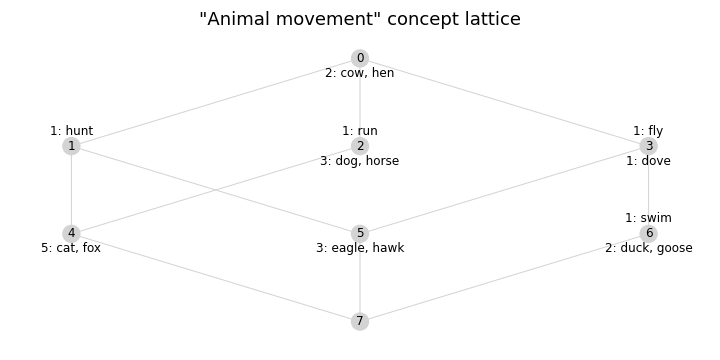🧠 Formal Concept Analysis with focus on Cognitive Psychology
A library to work with formal (and pattern) contexts, concepts, lattices
Created under the guidance of S.O.Kuznetsov and A.A.Neznanov of HSE Moscow.
FCApy can be installed from PyPI:
- pip install fcapy
The library has no strict dependencies. However one would better install it with all the additional packages:
- pip install fcapy[all]
The library provides an implementation of the Formal Context idea from FCA. An example of this is given in here.
The library consists of 4 main subpackages:
An implementation of Formal Context from FCA theory.
Formal Context K = (G, M, I) is a triple of set of objects G, set of attributes M and a mapping I between them. A natural way to represent a Formal Context is a binary table.
Formal Context provides two main functions:
extension(attributes) - return a maximal set of objects which share attributesintention(objects) - return a maximal set of attributes shared by objectsThese functions are also known as “prime (‘) operations”, “arrow operations”
For example, ‘animal_movement’ context shows the connection between animals (objects) and actions (attributes)
!wget https://raw.githubusercontent.com/EgorDudyrev/FCApy/main/data/animal_movement.csvctx = read_csv('animal_movement.csv')print(ctx[:5])> FormalContext (5 objects, 4 attributes, 7 connections)> |fly|hunt|run|swim|> dove | X| | | |> hen | | | | |> duck | X| | | X|> goose| X| | | X|> owl | X| X| | |print(ctx.extension(['fly', 'swim']))> ['duck', 'goose']print(ctx.intention(['dove', 'goose']))> ['fly']
Thus we can state that all the animals who can both ‘fly’ and ‘swim’ are ‘duck’ and ‘goose’.
The only action both ‘dove’ and ‘goose’ can performs if ‘fly’.
At least this is formally true in ‘animal_movement’ context.
A detailed example is given this notebook.
An implementation of Concept Lattice object from FCA theory. That is a partially ordered set of Formal concepts.
A Formal Concept is a pair (A, B) of objects A and attributes B s.t. A contains all the objects which share attributes B and B contains all the attributes which shared by objects A.
In other words:
A = extension(B)B = intention(A) A concept (A1, B1) is bigger (more general) than a concept (A2, B2) if it describes the bigger set of objects (i.e. A2 is a subset of A1, or (which is the same) B1 is a subset of B2)
Applied to ‘animal_movement’ context we get this ConceptLattice:
from fcapy.lattice import ConceptLatticeltc = ConceptLattice.from_context(ctx)print(len(ltc.concepts))> 8import matplotlib.pyplot as pltfrom fcapy.visualizer import Visualizerplt.figure(figsize=(10, 5))vsl = Visualizer(ltc)vsl.draw_networkx(max_new_extent_count=5)plt.xlim(-1,1.5)plt.show()

In this Concept Lattice a concept #3 contains all the objects which can ‘fly’. These are ‘dove’ plus objects from more specific concept #6: ‘goose’ and ‘duck’.
A concept #4 represents all the animals who can ‘run’ (acc. to more general concept #2) and ‘hunt’ (acc. to more general concept #1).
An implementation of Many Valued Context from FCA theory.
MVContext is a generalization of Formal Context. It allows FCA to work with any kind of object description defined by Pattern Structures.
Pattern Structure D is a set of descriptions s.t. we can use to it to run extension and intention operations.
At this moment, only numerical features are supported.
#load data from sci-kit learnfrom sklearn.datasets import fetch_california_housingcalifornia_data = fetch_california_housing(as_frame=True)df = california_data['data'].round(3)from fcapy.mvcontext import MVContext, PS# define a specific type of PatternStructure for each column of a dataframepattern_types = {f: PS.IntervalPS for f in df.columns}# create a MVContextmvctx = MVContext(df.values, pattern_types=pattern_types, attribute_names=df.columns)print( mvctx )> ManyValuedContext (20640 objects, 8 attributes)# Get the common description of the first 2 housesprint( mvctx.intention(['0', '1']) )> {'MedInc': (8.301, 8.325), 'HouseAge': (21.0, 41.0), 'AveRooms': (6.238, 6.984),> 'AveBedrms': (0.972, 1.024), 'Population': (322.0, 2401.0), 'AveOccup': (2.11, 2.556),> 'Latitude': (37.86, 37.88), 'Longitude': (-122.23, -122.22)}# Get a number of houses with an age in a closed interval [10, 21]print( len(mvctx.extension({'HouseAge': (10, 21)})) )> 5434
A number of algorithms to use FCA in a supervised ML scenario.
#load data from sci-kit learnfrom sklearn.datasets import fetch_california_housingcalifornia_data = fetch_california_housing(as_frame=True)df = california_data['data']y = california_data['target']from fcapy.mvcontext import MVContext, PS# define a specific type of PatternStructure for each column of a dataframepattern_types = {f: PS.IntervalPS for f in df.columns}# create a MVContextmvctx = MVContext(df.values, target=y.values,pattern_types=pattern_types, attribute_names=df.columns)print( mvctx )> ManyValuedContext (20640 objects, 8 attributes)# split to train and test setmvctx_train, mvctx_test = mvctx[:16000], mvctx[16000:]# Initialize a DecisionLattice model (which uses RandomForest in the construction process)from fcapy.ml.decision_lattice import DecisionLatticeRegressorrf_params = {'n_estimators':5, 'max_depth':10}dlr = DecisionLatticeRegressor(algo='RandomForest', algo_params={'rf_params':rf_params})# Fit the model%time dlr.fit(mvctx_train, use_tqdm=True)> CPU times: user 43.1 s, sys: 67.8 ms, total: 43.1 s> Wall time: 43.1 s# Predict the valuespreds_train_dlr = dlr.predict(mvctx_train)preds_test_dlr = dlr.predict(mvctx_test)## sometimes a test object can not be described by any concept from ConceptLattice## in this case the model predicts None. We replace it with mean target value over the train contextpreds_test_dlr = [p if p is not None else mvctx_train.target.mean() for p in preds_test_dlr]# Calculate the MSEfrom sklearn.metrics import mean_squared_errormean_squared_error(mvctx_train.target, preds_train_dlr), mean_squared_error(mvctx_test.target, preds_test_dlr)> (0.15651125729264054, 0.5543609802892809)# Fit a Random Forest model for the comparisonfrom sklearn.ensemble import RandomForestRegressorrf = RandomForestRegressor(**rf_params)%time rf.fit(df[:16000], y[:16000])> CPU times: user 240 ms, sys: 0 ns, total: 240 ms> Wall time: 238 mspreds_train_rf = rf.predict(df[:16000])preds_test_rf = rf.predict(df[16000:])mean_squared_error(mvctx_train.target, preds_train_rf), mean_squared_error(mvctx_test.target, preds_test_rf)> (0.16501598118202618, 0.48447718343174856)
DecisionLattice works slower and gives less accurate test predictions than a Random Forest. For now…